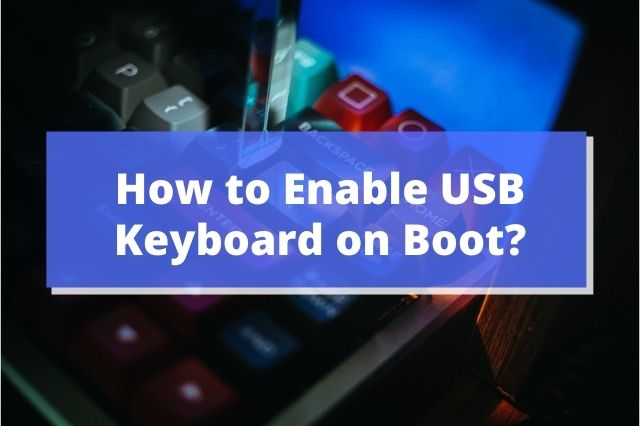This is a question asked commonly by many people, how to enable USB keyboard on boot? Especially when they need to use the keyboard on the boot menu for installing windows or accessing BIOS. However, sometimes the keyboard doesn’t work at a startup, and you can’t press your corresponding keys. What should you do then?
There are only two options – you either fix the keyboard or replace it. If you want to try to fix the keyboard, here are the steps:
Enable USB Keyboard on Boot 5 Steps?
1. Shut down your computer before disconnecting all cords and cables except for the power cord.
2. Open up your computer. On most computers, you can do this by removing the screws on the back of the case and then sliding the cover off (make sure to keep track of the screws). Some computers have side panels that you can unscrew and remove.
3. Locate the motherboard (the main circuit board) inside your case, find an expansion slot for a keyboard, and install the PS/2-to-USB adapter. Then connect one end of your USB cord to this port and the other end to your keyboard.
4. Close your computer and reconnect all cords and cables, including the power cord.
5. Turn on your computer and press the key corresponding to the USB port you plugged your keyboard into (usually F2, but it could also be F10, ESC, or Delete). The BIOS screen should appear.
6. Navigate to the Boot tab and change the boot order so that your USB port is first (the best option).
7. Save your changes and exit BIOS. The computer will restart, and you should use your keyboard at the startup or boot menu.
If you don’t want to fix the keyboard, you should replace it with a new one. You can buy one at an office supply store or online.
Why Do We Use Boot Menu?
Some boot menus are not accessible to users. These boot menus often appear during the startup but are never to be seen again. The one you can see every time your computer starts is called ‘the standard boot menu, while the other one, which is not accessible to the user’s eyes, is called the hidden boot menu.
The hidden boot menu is essential for users because it contains some options that the typical boot menu doesn’t have. For example, if you want to change the default system language or time format, you must use the hidden boot menu. This is also where you can find some additional diagnostic tools for your computer.
Trouble Shooting Of The Keyboard With PS2
There are a few things you can do to troubleshoot a keyboard with a PS2 connector:
- Check the cable for damage. Please make sure there are no damaged portions in the cable and that it is securely plugged into the computer and the keyboard.
- Make sure the keyboard is turned on. Some keyboards have a power switch at the back.
- Ensure all the connections are tight on both the keyboard and computer ports.
- Use another keyboard to see if something is wrong with that specific one. If it works with another keyboard, you probably need a new one.
- If you have access to a PS2 connector tester, you can use that to test the keyboard.
Note: If all of these things have been tried and the keyboard still does not work, then it is likely that the motherboard or some other component in the computer is faulty. In this case, you will need to take it to a technician for repair.
If you are looking for the best wireless keyboards with a built-in touchpad, you should read this complete comparison of the best products.
FAQs
What Is The Boot Menu Key?
A boot menu key is an option related to BIOS or UEFI that allows you to boot your computer from an external device. The early laptops had only one button to enter and exit the BIOS/UEFI.
Since the early days, laptops developed the ‘F11’ key to access the BIOS menu and then the ‘F12’ key to enter and exit the UEFI. The latter has evolved through past laptops and dual in-keyboard chassis like the GX700 to become the ‘F12’ key accessible from most keyboards and laptops.
What Is Fast Boot In BIOS?
It checks whether all the memory modules are enabled and connected correctly when the system boots up. Because of that, when the computer starts up, it takes some time. If you turn off your machine, it will take time to boot up again.
Fast boot is an option in your system BIOS that speeds up your system startup process significantly. Try enabling this option if you run into boot issues while booting your computer. Fast boot in your system BIOS is an innovative solution that has been formulated over time with little to no trouble.
What Is The Advanced Boot Options Menu?
The “Advanced” boot options menu, also called the “Advanced Startup Options” menu, is in the boot menu and is accessed by pressing the “alt-b” key combination twice in rapid succession. This brings up a new Boot Options menu that contains four main options, with each of them having sub-menu options: Boot Settings, Boot Options, Boot Priority, and Restart Options.
The Boot Options menu allows you to adjust your boot options from Windows 7 and Windows 10 to adjust options such as your device’s time and date, USB legacy support, and recovery options.
Conclusion
Hopefully, one of these troubleshooting tips will fix the problem with your keyboard! And we hope that you are now satisfied with the answer to “how to enable USB keyboard on boot.” If not, then it is likely time to buy a new one.


1 thought on “How to Enable USB Keyboard on Boot? | 5 Easy Methods”